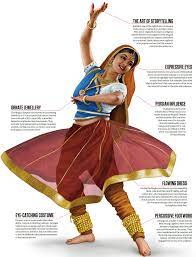17 Jan 2022 Kathak

- Recently famous Kathak dancer Pandit Munna Shukla passed away.
- His most famous works include the dance-drama Shaan-e-Mughal, Inder Sabha, Amir Khusro, Anga Mukti, Anvesha, Bahar, Tratak, Kraunch Badh, Dhuni.
- His contribution to the world of dance was honored with Sangeet Natak Akademi Award (2006), Sahitya Kala Parishad Award (2003) and Saraswati Samman (2011).
Introduction:
- The word Kathak is derived from the word Katha which literally means to tell a story. This dance is mainly performed in northern India.
- It was mainly a temple or village performance in which dancers narrated stories from ancient texts.
- It is one of the classical dances of India.
Development:
- With the spread of the Bhakti movement in the fifteenth and sixteenth centuries, Kathak dance developed as a distinct form.
- The legends of Radha-Krishna were first used in folk plays called ‘Raas Leela’, which later added folk dances to the original gestures of Kathak storytellers.
- Kathak was performed in the court under the Mughal emperors and their nobles, where it acquired its present characteristics and developed into a distinctive style.
- It developed into a major art form under the patronage of Wajid Ali Shah, the last Nawab of Awadh.
Dance Style:
- Usually a solo storyteller or dancer pauses for a while to recite the verses and is then performed through physical movements.
- During this more attention is paid to the movement of the legs; Body movements are skillfully controlled by dancers wearing ‘ankle-bells’ and performed with straight legs.
- ‘Tatkar’ Kathak basically involves the movement of the feet.
- Kathak is the only form of classical dance that is related to Hindustani or North Indian music.
- Some of the prominent dancers include Birju Maharaj, Sitara Devi.
Other Classical Dances in India
- Tamil Nadu- Bharatanatyam
- Kathakali – Kerala
- Kuchipudi – Andhra Pradesh
- Odissi- Odisha
- Satria- Assam
- Manipuri- Manipur
- Mohiniyattam- Kerala
Bhakti Movement:
- The Bhakti movement developed in Tamil Nadu between the seventh and ninth centuries.
- This was reflected in the sentimental poems of Nayanars (devotees of Shiva) and Alvars (devotees of Vishnu).
- These saints did not see religion as mere formal worship but as a love bond based on love between the worshiper and the worshiper.
- He wrote in the local languages, Tamil and Telugu and hence was able to reach many people.
- Over time the ideas of the South moved towards the North but it was a very slow process.
- A more effective way of spreading the Bhakti ideology was the use of local languages. Bhakti saints composed their verses in local languages.
- He also translated into Sanskrit to make them understandable for a wider audience. Examples include Gyandev in Marathi, Kabir, Surdas and Tulsidas in Hindi, Sankardev who popularized Assamese, Chaitanya and Chandidas who spread his message in Bengali, Mirabai and Rajasthani in Hindi.


No Comments